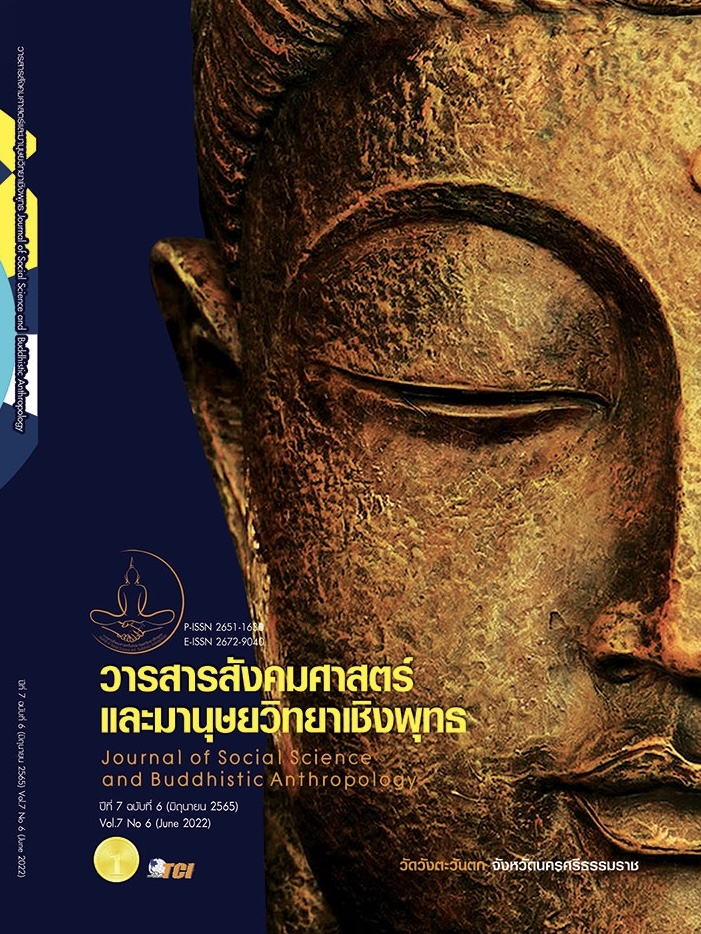THE CULTURAL LANDSCAPE OF BUDDHIST MEDITATION TEACHERS FOR RELIGIOUS TOURISM IN THE LOWER NORTHEAST
Keywords:
Cultural landscape, Buddhist meditation teachers, religious tourism, Thammayut Nikaya, lower Northeastern regionAbstract
The objectives of this research article were to study the origin of Development and expansion of the Dhammayut sect; and cultural landscapes of Vipassana teachers to promote religious tourism in the lower Isan area. It is a qualitative research with both documentary and field studies. The research tools are observation form, interview form and small group discussion form. The target groups were monks, local knowers, community leaders, scholars and tourists, amounting to 50 monks/person. The origin of the Vipassana teacher in the Northeast is Ubon Ratchathani province. It has spread of the Thammayut sect from Bangkok by Phra Ajahn Dee Panthulo, who was a Purana Saha Dhammakaya of Phra Vajirayan or King Rama IV. It was expanded into 3 eras. In the first period, there was an expansion of religion by taking a motion of monks from the Maha Nikaya to become Dhammayutika Sect. The second era has the expansion of monasteries and in the 3rd era, there is the emergence of Vipassana teachers in the area, namely Phra Ajarn Sao Kantasilo, Phra Ajarn Mun Phurithatto, Reverend Cha Suphatto, Reverend Dun Atulo, and Reverend Phut thaniyo, etc. The cultural landscape of Vipassana teachers in the area can be grouped into 6 groups: 1) important monasteries group 2) pagoda group 3) museum group 4) sacred Buddha image group 5) relic group 6) religious group and can be synthesized into 2 large groups, namely 1) the original resource group in the era of the Vipassana teacher such as the sacred Buddha image, eight necessities of a Buddhist monk (Atthaborikhan) and monasteries, etc., and 2) the resource group that was developed or created later, such as pagoda and museums. etc., which can organize religious resources as a religious tourism route under “Tourism Route for ordained teachers”
References
เติม วิภาคย์พจนกิจ. (2546). ประวัติศาสตร์อีสาน. (พิมพ์ครั้งที่ 4). กรุงเทพมหานคร: สำนักพิมพ์มหาวิทยาลัยธรรมศาสตร์.
ธวัช ปุณโณทก. (2551). พระพุทธศาสนาในภาคอีสานและล้านช้าง. ใน เอกสารประกอบการสัมมนาเชิงวิชาการ เรื่อง “พระพุทธศาสนาลุ่มน้ำโขง” ณ โรงแรมซันพาเลช จังหวัดเลย, 9-12 กรกฎาคม 2551. มมร. เลย.
ธีระพงษ์ มีไธสง. (2556). ฮดสรง: ภูมิปัญญาพื้นบ้าน พิธีเถราภิเษกพระสงฆ์ในภาคอีสาน. (พิมพ์ครั้งที่ 2). มหาสารคาม: อภิชาตการพิมพ์.
ธีระพงษ์ มีไธสง. (2562). การปรับตัวพุทธศาสนาในอีสานท่ามกลางการแพร่กระจายแนวคิดแบบพระสายวัดป่า ธรรมยุติกนิกาย. วารสารภาษา ศาสนาและวัฒนธรรม, 8(1), 156-175.
ปฐม นิคมานนท์. (2546). พระครูวิเวกพุทธกิจ หลวงปู่ใหญ่เสาร์ กันตสีโล. กรุงเทพมหานคร: พี.เอ.ลีฟวิ่ง จำกัด.
พระครูอุบลคณาภรณ์. (7 กุมภาพันธ์ 2564). ประวัติธรรมยุติกนิกายในจังหวัดอุบลราชานี. (ฉลอง พันธ์จันทร์, ผู้สัมภาษณ์)
พระธรรมปิฎก (ป.อ. ปยุตฺโต). (2539). จาริกบุญ จารึกธรรม. (พิมพ์ครั้งที่ 3). กรุงเทพมหานคร: สหธรรมิก.
พระธรรมปิฎก (ป.อ. ปยุตฺโต). (2546). พุทธธรรม. (พิมพ์ครั้งที่ 11). กรุงเทพมหานคร: โรงพิมพ์มหาวิทยาลัยมหาจุฬาลงกรณราชวิทยาลัย.
พระธัมมธโร. (2556). ธรรมประวัติหลวงปู่จาม มหาปุญโญ ผู้มากมีบุญ. กรุงเทพมหานคร: สำนักพิมพ์มติชน.
พระมหานามเถระและคณะบัณฑิต. (2553). คัมภีร์มหาวงศ์ ภาค 1. สุเทพ พรมเลิศ. ผู้แปล. กรุงเทพมหานคร: โรงพิมพ์มหาวิทยาลัยมหาจุฬาลงกรณราชวิทยาลัย.
พระวิบูลย์ธรรมาภรณ์. (6 กุมภาพันธ์ 2564). ประวัติวัดสุปัฎนาราม. (ฉลอง พันธ์จันทร์, ผู้สัมภาษณ์)
ภัทรพร สิริกาญจน. (2557). พระพุทธศาสนาในประเทศไทย: เอกภาพในความหลากหลาย. กรุงเทพมหานคร: สำนักพิมพ์มหาวิทยาลัยธรรมศาสตร์.
มหาจุฬาลงกรณราชวิทยาลัย. (2539). พระไตรปิฎกฉบับภาษาไทย ฉบับมหาจุฬาลงกรณราชวิทยาลัย. กรุงเทพมหานคร: โรงพิมพ์มหาวิทยาลัยมหาจุฬาลงกรณราชวิทยาลัย.
มาโนช พรหมปัญโญและคณะ. (2556). แนวทางการเตรียมความพร้อมการท่องเที่ยวเชิงพุทธของจังหวัดอุบลราชธานี. วารสารการบริการและการท่องเที่ยวไทย, 8(2), 36-47.
เรืองเดช เขจรศาสตร์. (2549). วิถีพุทธธรรมตามแนววัดป่าภาคอีสานกับการพัฒนาศักยภาพมนุษย์. ใน ดุษฎีนิพนธ์ปรัชญาดุษฎีบัณฑิต สาขาไทยศึกษา. มหาวิทยาลัยมหาสารคาม.
ศรีศักร วัลลิโภดม. (2546). แอ่งอารยธรรมอีสาน. กรุงเทพมหานคร: สำนักพิมพ์มติชน.
ศูนย์อาเซียนศึกษา มหาวิทยาลัยมหาจุฬาลงกรณราชวิทยาลัย. (2560). พระพุทธศาสนาในอาเซียน ท่ามกลางความหลากหลายของพหุสังคม วัฒนธรรม และศาสนา เล่ม 1. นนทบุรี: ห้างหุ้นส่วนจำกัด เชนปริ้นติ้ง.
สำนักงานสภาพัฒนาการเศรษฐกิจและสังคมแห่งชาติ. (2561). ยุทธศาสตร์ชาติ (2561-2580) ฉบับประชาชน. เรียกใช้เมื่อ 20 พฤศจิกายน 2564 จาก http://nscr.nesdb.go.th/wp-content/uploads/2020
สุชาดา ทวีสิทธิ์. (2552). ลุ่มน้ำโขงศึกษา: สายน้ำ ผู้คน ชายแดน วัฒนธรรม การค้า การเมือง. วารสารศิลปศาสตร์ มหาวิทยาลัยอุบลราชธานี, 5(ฉบับพิเศษ), 6-16.
สุทิตย์ อาภากโร และสายชล ปัญญชิต. (2554). รูปแบบของเครือข่ายการเรียนรู้ทางสังคมในการท่องเที่ยวทางพระพุทธศาสนา. เรียกใช้เมื่อ 20 พฤศจิกายน 2564 จาก ejournals.swu.ac.th/index.php/JOS/article/viewFile/3811/3800
Feilden, M. & Jokilehto, J. (1998). Management guidelines for world cultural Heritage site. Rom, Italy: ICCROM.
UNESCO. (2005). The Convention on the Protection and Promotion of the Diversity of Cultural Expressions. Retrieved November 20 , 2021, from https://en. unesco.org/creativity/convention
Downloads
Published
How to Cite
Issue
Section
License
Copyright (c) 2022 Journal of Social Science and Buddhistic Anthropology

This work is licensed under a Creative Commons Attribution-NonCommercial-NoDerivatives 4.0 International License.








